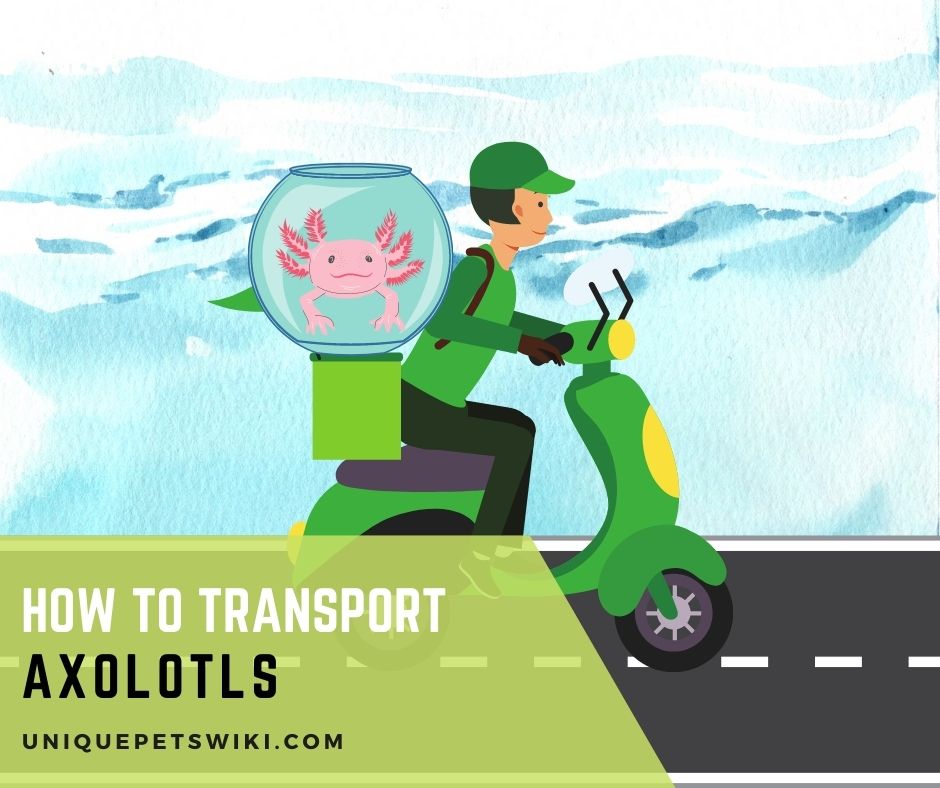The way we seek to travel in well-spaced and comfortable vehicles is no different with axolotls.
They feel uneasy when transported haphazardly. Furthermore, axolotls’ bodies are delicate and vulnerable to injuries if mishandled.
So then, when you are traveling and would like to move with your cute salamander, considering its safety is a key factor.
You do not want to reach your destination and start looking for a vet because your axie was hurt.
Axolotls need to stay in intimate contact with water, whether you’re moving them or not. Keeping them outside water even for a minute is not recommended.
With all that said, it’s imperative to know the best method on how to transport axolotls safely. Deep dive into the article to learn the safety procedures of moving these amphibians.
Contents
How to Transport Axolotls
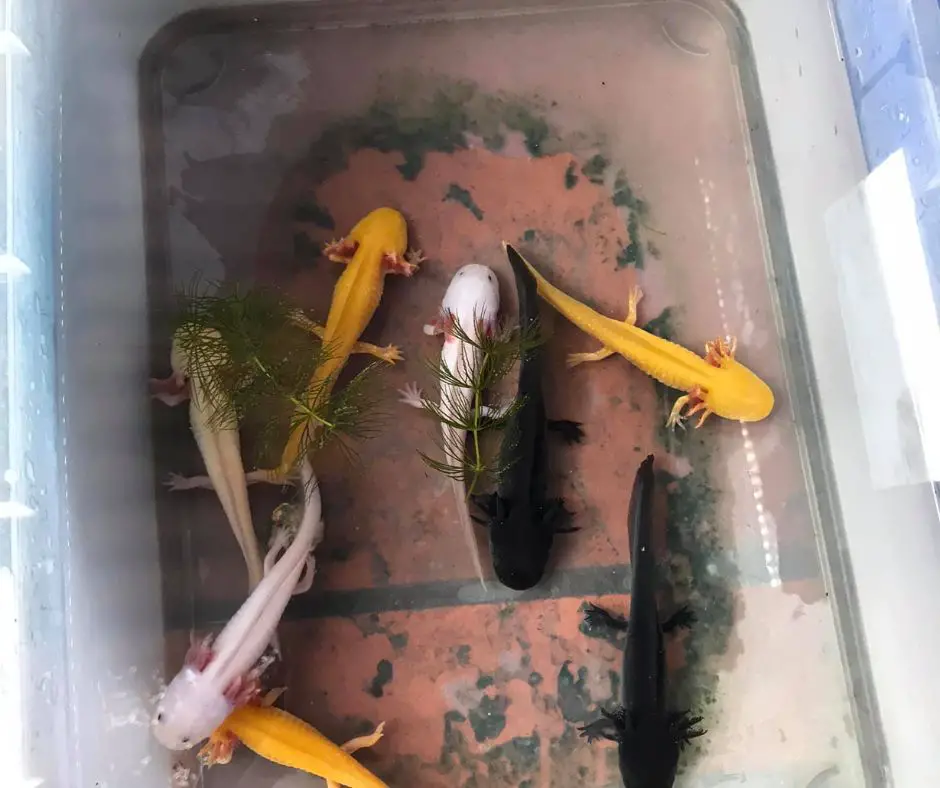
First and foremost, ensure your axolotl is healthy before you transport it. Moving a sick axolotl can accelerate stress and cause more harm than you think.
Moreover, if you’re out there to buy an axolotl, you must confirm you’re buying a healthy animal, especially if you source it from craigslist or unreputable breeders.
Once you confirm your pet is in good shape, there is nothing to stop you now from transporting it. You can use a bag or Tupperware container in the transportation.
They are both convenient and reliable methods for any axolotl caretaker to use when making a short journey.
However, long distances require you to hire a pet shipping company to ensure your axie is humanely transported in the best condition.
But if you’re moving for eight hours utmost, you can do the transport yourself as long as you adhere to the right procedures.
Using Bags to Transport Your Axolotl
Self-transporting axolotls in water in a bag is a common and effective way to move with your axie. You can be sure that your axolotl is safe in its shipping bag and will survive in it even for a day.
You don’t need to go through complicated steps to figure out how to bring your axie into its shipping bag or the kind of bag to use.
All you need with this method is to gather the right tools together, put the axolotl in the bag, and put the bag in the cooler. See complete details for each approach below.
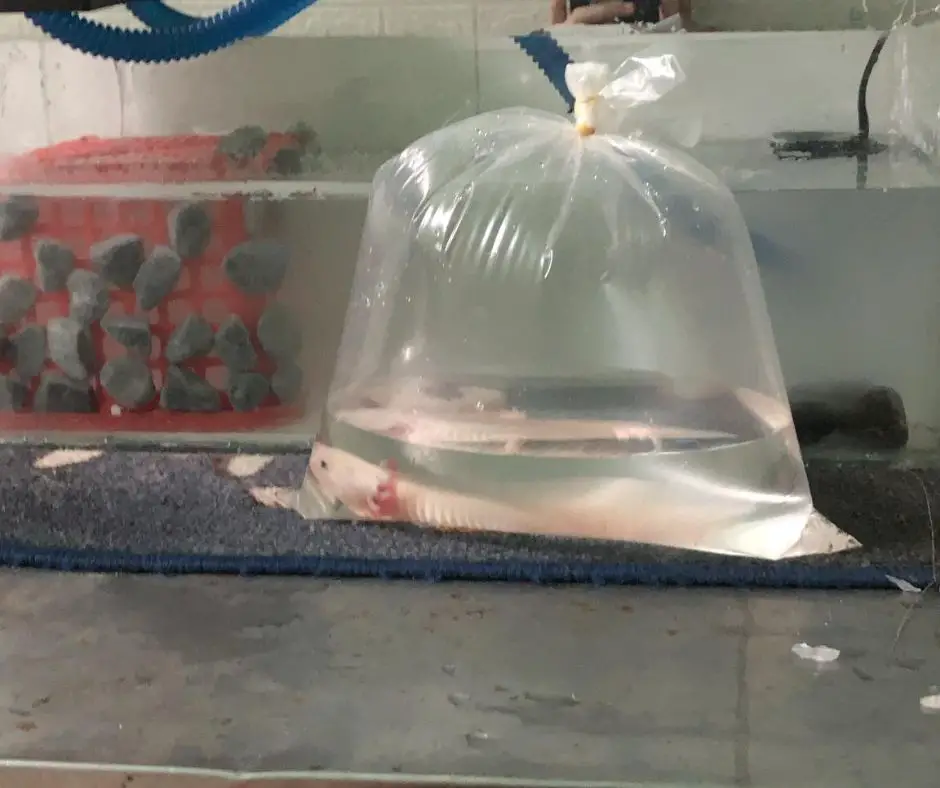
Step 1: Prepare Tools
Pet stores sell bags to transport various aquatic animals, including axolotls. Fish bags can excellently accommodate an axolotl during its transportation.
Go for a plastic bag close to 15 by 8 inches in length and width respectively, which is big enough to cover your axie with water and still leaves about 2/3 space for air.
If you have them, you may also want to use heavy-duty gallon storage bags from your kitchen. The bag method is safer because it reduces sloshing.
You will also need a large fishnet, rubber band, and some coolers. After gathering all the tools, now you’re free to prepare the axolotl for the journey.
APQ Aquarium Plastic Fish Bags
- PACK OF 100 LEAK PROOF PLASTIC BAGS 6" x 12": Unprinted clear plastic aquarium fish bags are ideal for transporting pets and forage fish. The fish transport bags are easy to store and use. Goldfish container is safety and convenience.
- EXCEPTIONAL QUALITY: The fish bags are made of 100% virgin low-density polyethylene, so there is no threat to your fish. Packing bags plastic are clear and transparent, which allows you to watch the fish all the time with aquarium fish bag.
- DURABLE MATERIAL: Fish containers are suitable for transporting and storing live fish. In addition, the goldfish plastic container is waterproof. Water does not get inside or outside the fish carrying bag.
- COST-EFFECTIVE: One of the best qualities of live fish package like plastic bags for fish transport is their incredible durability and strength. Fish transport container is one of the most efficient and inexpensive ways to pack and transport fish.
- VARIETY OF USE: Goldfish bags are designed for transporting live fish! Thus, the 2 mil poly bag is ideal for fish markets, seafood restaurants, and pet stores. The large capacity of poly bags allows shipping fish with comfort.
Last update on 2023-01-02 / Affiliate links / Images from Amazon Product Advertising API
Step 2: Put the Axolotl in the Bag
Transfer the axolotl to the bag while it’s empty and add water after that. Instead of catching the axie directly with your hand, use the fishnet and remove the axolotl from its aquarium.
Introduce the axolotl in the bag and then fill 1/3 of it with the aquarium water to ensure your little friend is fully submerged in water.
The aquarium water is dechlorinated and, therefore, free from chlorine and chloramines that threaten axolotls.
Its parameters are also at a standard level where axolotls are safe and comfortable. It’s advisable to keep the axolotl in this water some hours prior to transportation to see its reaction.
Pump or blow air into the remaining 2/3 bag’s space using a bike pump. Otherwise, if you can tolerate blowing air into the bag with your mouth, I wouldn’t forbid you.
Not skipping this step is necessary since it ensures that more oxygen is sealed within. Eventually, seal the bag by folding it over its top and tying it tightly with a rubber band.
Introduce the sealed axie inside another plastic bag and wrap it like the first. Using two bags helps to avoid leakage.
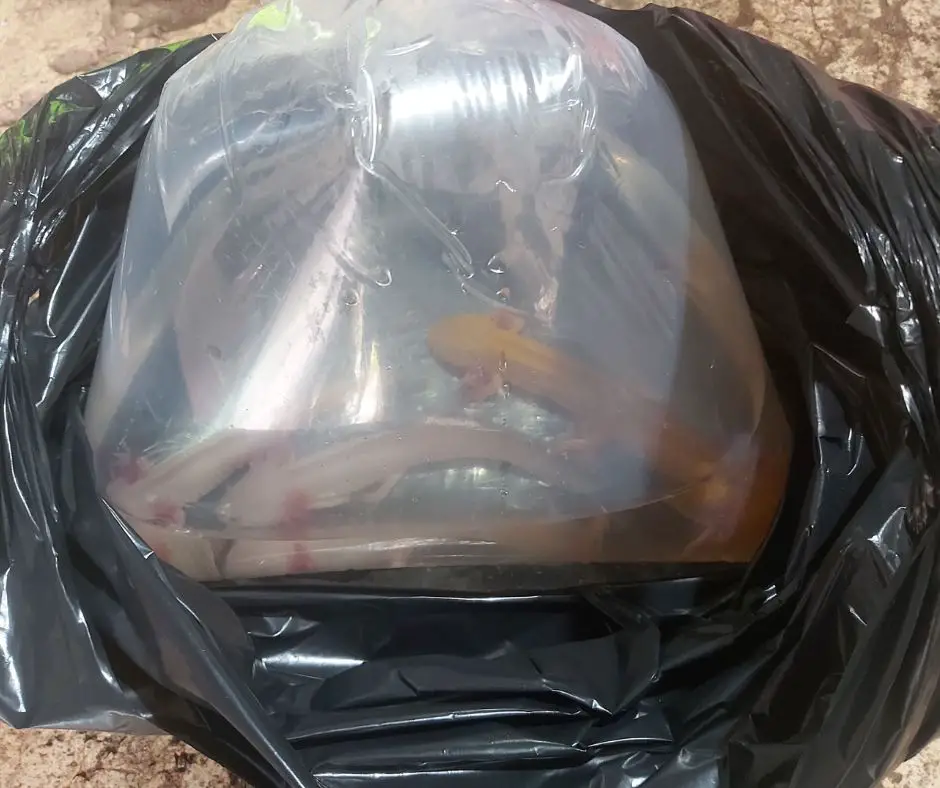
Step 3: Put the Axolotl Bag into The Cooler
Put the cooler in place, and provide a layer of packing peanuts at the bottom. These packing materials provide a cushion when transporting your axolotl. Finally, place your axie on the layer.
Be sure to surround the axolotl with more packing peanuts to ensure against it moving around at all.
When the climate is cold, you may want to provide a frozen water ball down the side of the cooler immediately beneath the packing peanuts.
Be extremely careful for the sealed axolotl not to touch the water ball directly to prevent your friend from becoming too cold.
If the water gets above 70 degrees Fahrenheit, it will be intolerable for the axolotl.
Finish this process by taping the outside of the cooler to keep it closed throughout the trip and provide you with a stress-free journey.
Coleman Portable Hard Cooler
- ICE RETENTION: TempLock insulation keeps drinks ice cold
- PORTABLE: Large-grip bail handle makes the cooler easy to carry with one hand
- QUICK-CLEAN TOP: Smoother surface wipes down easily
- DRINKS FOR ALL: Holds up to 4 cans with 4 lbs. of ice
- MADE IN THE USA
Last update on 2023-01-02 / Affiliate links / Images from Amazon Product Advertising API
Pros of Using the Bag Method
Compared to using solid containers, bags help reduce sloshing, thus providing a secure medium for the axolotl to relax during its transportation.
You can provide java moss inside the bag to give a place for the axolotl to cling to; it’s also a way of enhancing comfort.
Allowing 2/3 of air in the bag gives the axolotls fresh oxygen to breathe. Lastly, double bags prevent any chances of leaking.
The bag method is cheap and affordable to all users since it’s not a must you use the commercialized tool.
Cons Associated with Bag Method
For instance, It’s risky to keep axolotls too long inside the bag, for more than 24 hours. There will be oxygen depletion and accumulation of waste from the axolotl.
Also, if you didn’t blow enough air in the bag when sealing the axolotl, it can cause suffocation due to insufficient oxygen.
Fluctuation of external temperatures may affect the axolotl in poorly prepared bags. For example, when it’s too cold or hot, the water temperature also changes and deviates from the optimal level.
Using Tupperware to Transport Your Axolotl
The use of Tupperware containers is another best method of transporting axolotls. It’s a very common practice among the axolotls’ caretakers.
The same procedures we followed with the bag method also apply here. You need to prepare tools, put the axolotl in the Tupperware, and put the axolotl Tupperware in the cooler.
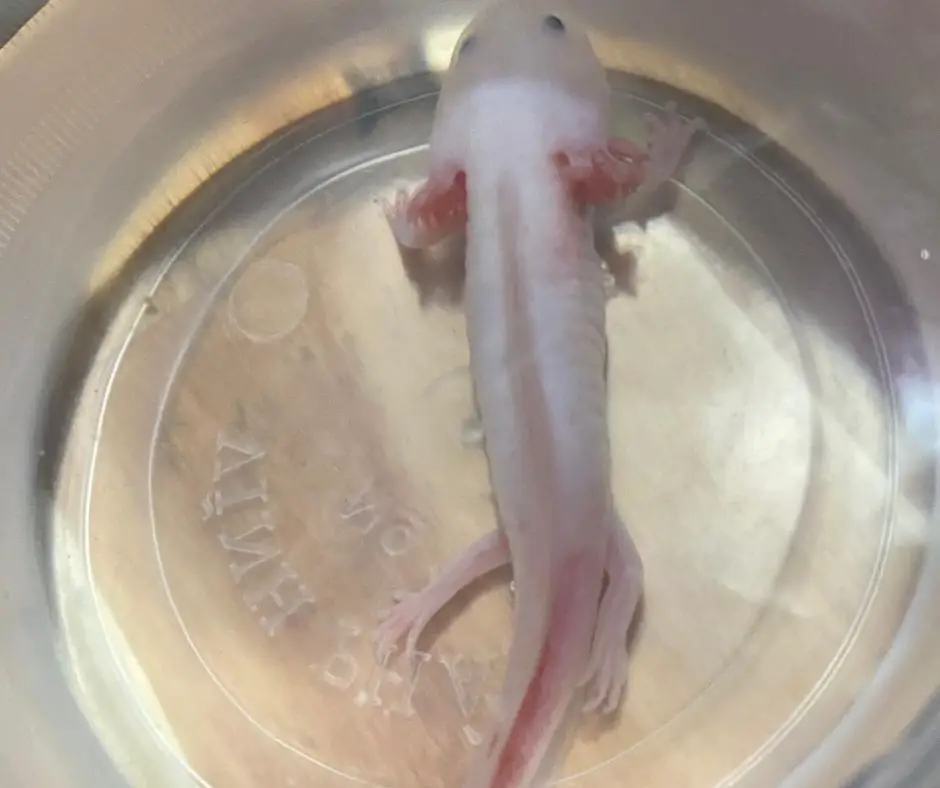
Step 1: Prepare Tools
Look for a Tupperware container holding about 2-3 gallons of water. Other essential tools include a large fishnet, cooler, and a soft towel.
You can get all this stuff from your local pet store. Ensure the cooler is enough to contain the Tupperware.
Rubbermaid 16-Piece Food Storage Containers with Lids and Steam Vents
- Food storage containers with Easy Find Vented Lids that snap on to the container base as well as same-size lids, so you can always find lids when you need them, and your cabinets stay organized
- Plastic containers are great for meal prep, leftovers, cabinet storage, and more
- Built-in vents are splatter-resistant; Reduces unnecessary clean-ups and messy microwaves
- Thick, durable container walls withstand everyday use and suitable for a wide range of temperatures
- Freezer-, top-rack dishwasher-, and microwave-safe base for easy care; Plastic containers are BPA-free and made with non-toxic plastic
Last update on 2023-01-02 / Affiliate links / Images from Amazon Product Advertising API
Step 2: Put the Axolotl in the Tupperware
Using a large fishnet, remove the axolotl from the aquarium and place it in an empty Tupperware. Subsequently, fill the container with 1/3 of the axie’s aquarium water.
Using the same water, your axolotl was in ensures against the sudden shock of the change in temperature and pH. Ensure the water is always dechlorinated.
You may decide to poke holes or cut a slit on top of the container to provide tiny spaces for air circulation.
However, where you will spend a prolonged period in transit, a battery-operated air-stone would be effective to ensure the water contains sufficient oxygen.
Step 3: Put the Axolotl Tupperware into the Cooler
Place the Tupperware in a cooler, put a soft towel above it, and then an ice pack. The ice pack helps to keep the temperatures down.
Next, bring the cooler to a shady location in your vehicle, which also helps prevent heat.
The best spot to place the cooler is on the seat and fasten it using the seatbelt. Carry a turkey baster with you to remove the feces from the Tupperware.
Pros of Tupperware Method
The Tupperware method’s advantage is that you can easily open the top lid and remove the poop using a turkey baster when checking the axolotl.
Furthermore, it’s advisable to have additional aquarium water in a separate insulated container, e.g., a thermos.
You will use it if you lose some water by taking too much of it with the turkey baster or checking your friend.
Tupperware is the best way to carry an axolotl without leakage, making it most convenient and superb.
The containers are also air-tight and durable. Not only that, these containers are light and easy to clean using the general cleaning methods.
Cons of this Method
You will have to spend more cash buying Tupperware since it is more expensive than the bag or plastic containers.
Exposing the container directly to light may interfere with the aquarium’s water temperature, which becomes stressful to the axolotl.
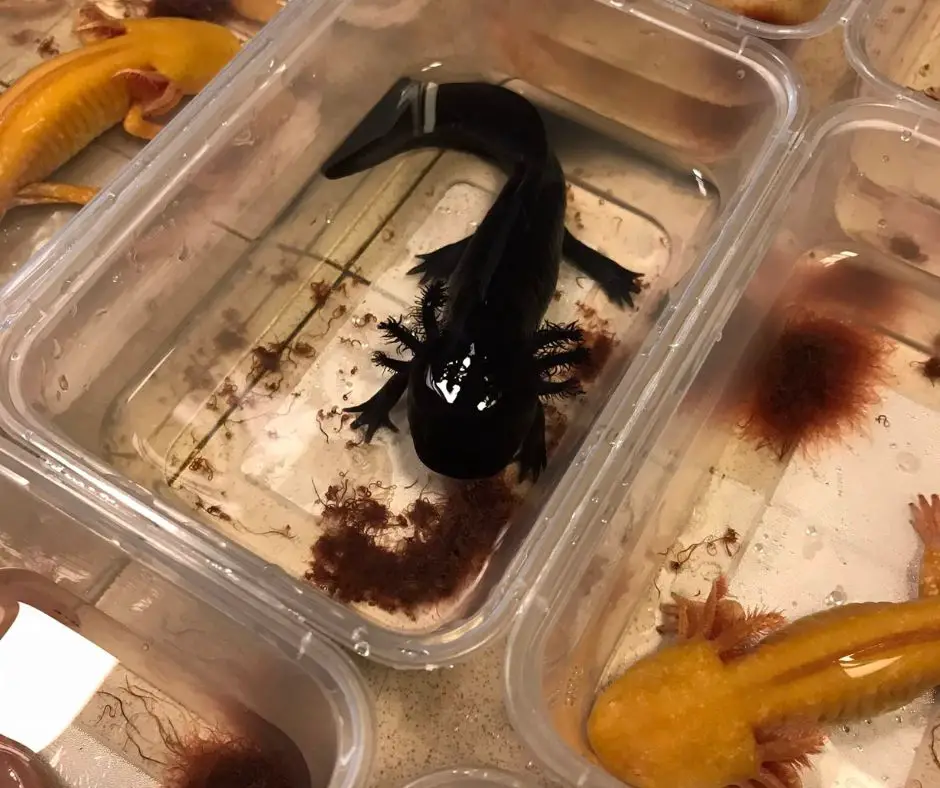
4 Tips to Transport Axolotls
You don’t suddenly wake up, put your axolotl in a shipping container, and set out on a journey. Transporting these creatures is a process that demands you to follow the right procedures.
After all, axolotls are delicate amphibians that are extremely vulnerable to injuries if you handle them anyhow.
To ensure success and avoid risks when moving your beloved axolotl, transport only healthy axolotls, place the box with axolotl in the best position, and plan for your trip and extra backup supplies.
Transport Only Healthy Axolotls
Check for any signs of illness to confirm your animal companion is healthy before preparing it for transportation. A sick axie will not be well enough for a trip.
If you have two axolotls leaving together, ensure none is hurt or stressed. Always put each axolotl in a separate bag or Tupperware when traveling.
If an axolotl is not eating or you notice its gills curled forward, the animal is perhaps unhappy/stressed or sick.
Other signs of stressed axolotls include deteriorating gills, folded tail tip, frequent floating, and gulping air frequently.
Happy axolotls have their gills flowing freely and effortlessly without tension; they eat properly, cheer up when you approach their tank, and look healthy by color.
You will see them moving around the tank actively.
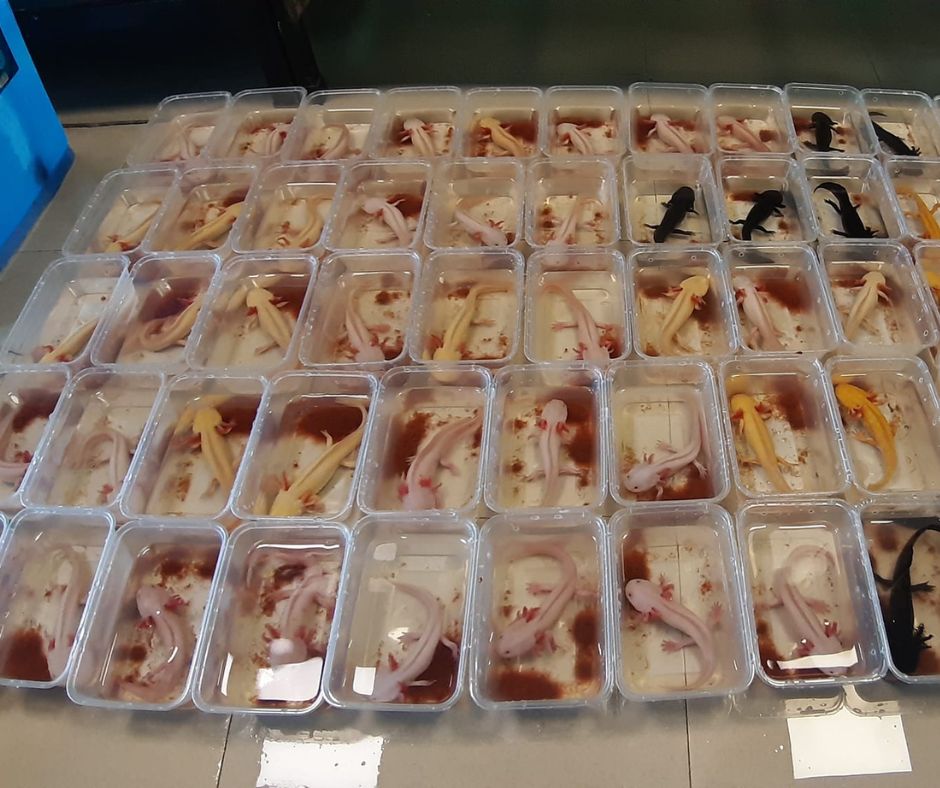
Place the Box in the Best Position
The conditions in the bag or Tupperware should imitate the aquarium’s conditions. The fluctuations of the parameters should be at their minimal level possible.
The smoother you will make these transitions, the better for your beloved friend. Both methods serve as a temporary home for axolotls during trips.
On that premises, ensure to handle your axie carefully and safely at this moment.
After checking that the axolotl is healthy and preparing it for the trip, you can put the cooler in a shady place in your vehicle to keep the temp down.
The best spot to choose, for that matter, is on a seat, and make sure to fasten the cooler with your seatbelt.
If you’re walking and holding the cooler, don’t move quickly as it will make the axolotl extremely stressful.
Plan for Your Trip
Plan your trip in advance to give you a humble time to gather everything and ensure against inconveniences during the last moments.
Know whether your trip will be nearby or in faraway places, and identify how long it will take to travel. That way, you will be able to choose the best shipping method of the axolotl to use.
It’s also wise to check what the weather condition is like. For instance, if it’s summertime, plan to travel very early in the morning or late in the evening to avoid the heat.
Moreover, if you travel by road, avoid bumpy and uneven roads.
Another benefit of earlier planning is that it allows you to plan your travel around the most convenient times to escape the city traffic or look for a route without traffic.

Backup Extra Supplies
Bring along with you extra supplies in case of emergencies and necessities. This saves you from wasting time looking for places to buy the materials you need, and it can save you money too.
Plan to take extra plastic bags, an ice pack or frozen water bottles, aquarium water, and a turkey baster.
Axolotls will not survive for too long in the absence of water; hence, you need extra aquarium water.
Also read: Can Axolotl Live Out of Water?
Wrapping Up
Axolotls are easy to transport from one location to another, even long distances, but you need to ensure they are healthy and use the right materials for transportation.
The two ideal methods of carrying these animals involve plastic bags or Tupperware containers.
Check the axolotl now and then, even when traveling, to ensure the water conditions are right and the axy is free from stress.
You can self-transport your axolotl using bags or Tupperware when going for a short trip. But if you’re traveling for more than 10 hours, it’s best to hire a pet shipping company to transport the axolotl for you.
